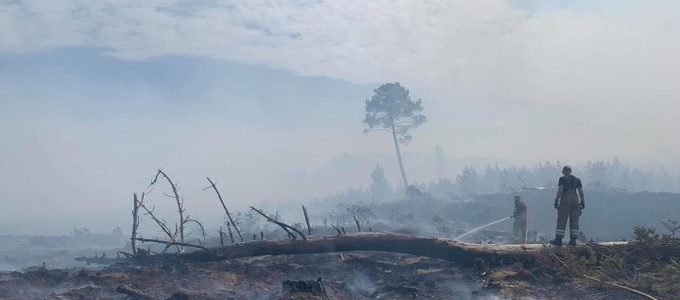
A year on from the Wareham Forest fire, which happened in May 2020, here are some statistics from the firefighting operation:
- The fire started on 18 May, and there was some form of fire service attendance on site until 4 June.
- A major incident was declared on the night of 18 May and remained in place until 29 May.
- Over the whole incident, firefighters from all 50 fire stations within DWFRS were involved in the operation – 70 of our 74 fire engines were used, including all eight heavy off-road pumps and all 14 light 4×4 pumps. There was also attendance from 22 over the border fire crews, mostly from Hampshire.
- At its peak, there were over 150 firefighters on scene tackling the blaze.
- The fire led to over 220 hectares of forest and heathland being destroyed – the equivalent of over 230 football pitches.
- There were nine drone deployments, from DWFRS, Dorset Police and Wiltshire Police.
- At the peak of the fire, 11.1km – that’s almost seven miles – of hose was deployed, using three high volume pumps. These are national assets, brought in from Christchurch, Wellington (Devon & Somerset FRS) and Hardley (Hampshire & IOW FRS). A fourth high volume pump from Avon also attended as a reserve. Together, these used around 4,400 litres of diesel!
- It is estimated that approx. four million litres of water were needed to fight the fire.
- To help fight the fire from the air, Forestry England brought in a specialist helicopter. An under-slung bucket holds up to 1,000 litres of water, which is dropped with great precision on the fire. Over two days, water was collected from a nearby lake, and was dropped on specific hot spots. The turnaround time from dropping a load of water to re-filling was very short, often around one minute, which made the technique very effective.
- Wildfire Tactical Advisors from Hampshire, West Sussex and South Wales FRSs attended, together with a tactical burn team from South Wales FRS, who led a series of prescribed burns to help control the spread of the fire. All of these specialist assets, aerial support, tactical burn teams, heavy plant and power tools were paid for by the land owners.
- Over 325 cases of bottled water were issued to the incident – with 24 in a case, that’s over 7,800 bottles, and that’s excluding refreshments provided by the Plymouth Brethren Rapid Relief Team, the Salvation Army and numerous donors!
- Within the Local Resilience Forum, 14 Tactical Coordinating Groups, two Strategic Coordinating Groups and one Recovery Coordinating Group were held virtually. These meetings set the multi-agency strategy and tactics for the incident and looked at off-site implications such as road closures, public warning & informing and any health effects of the smoke.
- The estimated cost of the incident to DWFRS was around £500,000.
A copy of the Wareham Forest Fire Report can be found below:

